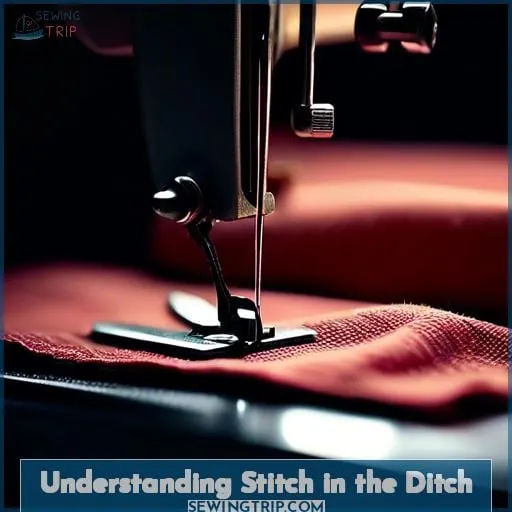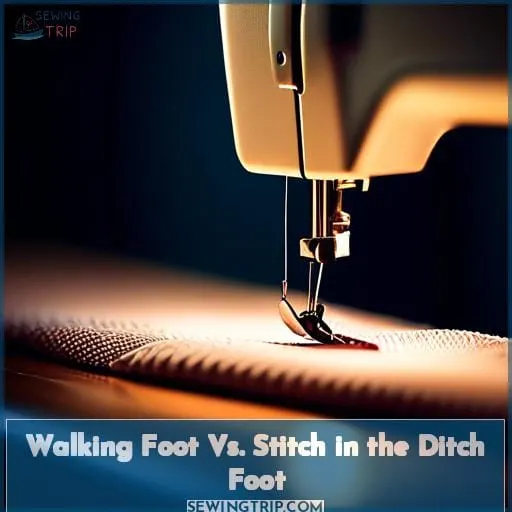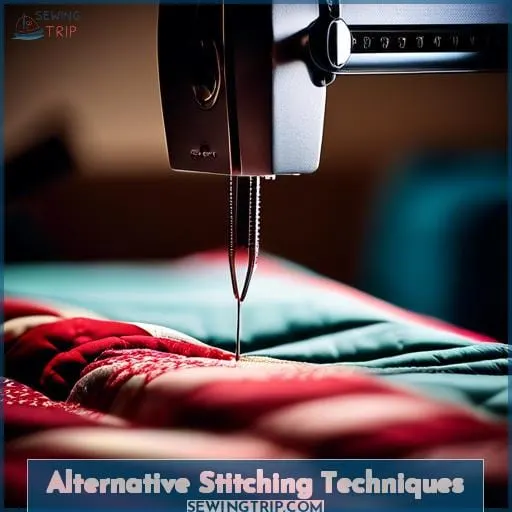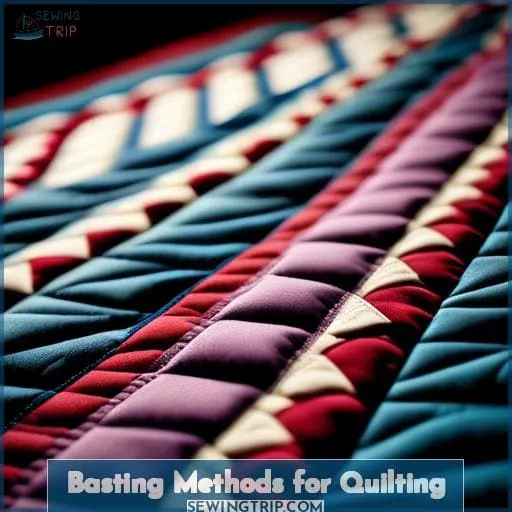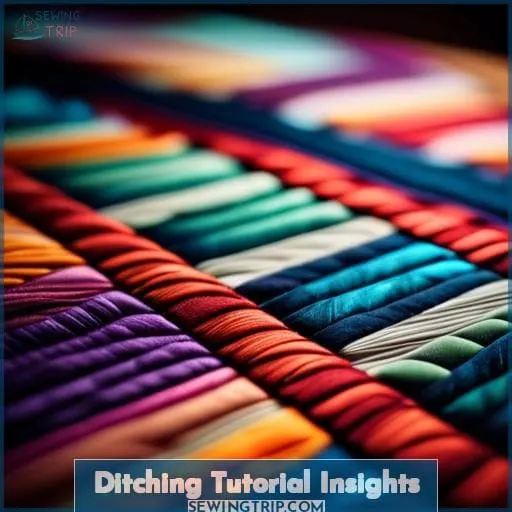This site is supported by our readers. We may earn a commission, at no cost to you, if you purchase through links.
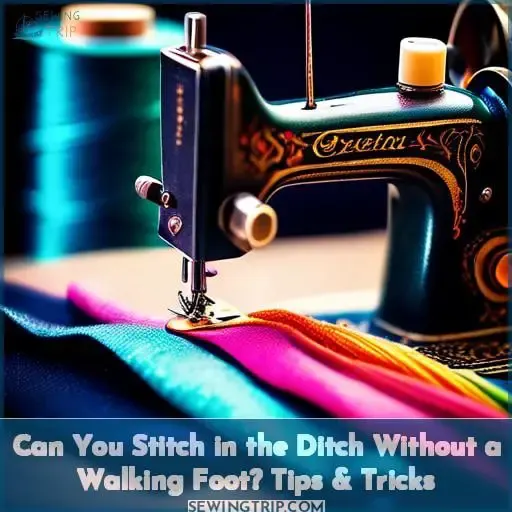
This guide will illuminate alternative methods that ensure your quilt’s layers are as harmonious as a symphony, with tips and tricks to maintain the integrity of your stitches.
Embrace the challenge and let’s dive into the art of ditch stitching, where every seam is a potential masterpiece.
Table Of Contents
- Key Takeaways
- Can You Stitch in the Ditch Without a Walking Foot
- Understanding Stitch in the Ditch
- Walking Foot Vs. Stitch in the Ditch Foot
- Alternative Stitching Techniques
- Basting Methods for Quilting
- Ditching Tutorial Insights
- Personalizing Your Quilting Approach
- Frequently Asked Questions (FAQs)
- Conclusion
Key Takeaways
- Seam alignment is crucial for successful stitch in the ditch quilting, and using a stitch in the ditch foot with a metal guide can help achieve precision even without a walking foot.
- Basting methods, including spray basting and pinning, are important to prevent fabric layers from shifting during the quilting process, which is a common concern when not using a walking foot.
- Free motion quilting and the use of a darning foot are alternative techniques that allow for creative expression and can be used effectively for stitch in the ditch quilting without a walking foot.
- Proper pressing and drying of the quilt before beginning to stitch in the ditch are essential to minimize bulk and ensure a flat surface, reducing the risk of needle breakage and improving the overall quality of the quilting.
Can You Stitch in the Ditch Without a Walking Foot
Yes, you can stitch in the ditch without a walking foot by using alternative methods such as free motion quilting or adjusting your regular presser foot settings. However, it may be more challenging and require careful handling to prevent fabric puckering.
Understanding Stitch in the Ditch
Diving into Stitch in the Ditch, think of it as your quilting secret weapon. Picture this: you’re at your sewing machine, quilting foot attached, ready to conquer those layers.
But first, let’s chat about the basics. Seams and pressing are your foundation; they’re like the best friends that hold everything together. Got your basting preferences sorted? Whether you’re a spray fanatic or a pinning pro, it’s all about keeping those layers snug.
Now, ditch width can be a bit of a wild card—some are wide, some are narrow. Slip on those quilting gloves for extra grip and comfort, and let’s aim for that perfect stitch length.
Walking Foot Vs. Stitch in the Ditch Foot
When it comes to handling multiple layers of fabric, a walking foot is your go-to tool as it prevents the layers from shifting during sewing.
For precision along fabric edges, a stitch in the ditch foot with its metal guide can help you achieve clean, straight lines.
Multiple Layers Handling
When tackling multiple layers, your walking foot is your trusty sidekick, ensuring an even feed without the dreaded fabric shifting.
It’s like having an extra set of hands, guiding your quilt through with precision for top-notch stitch quality.
Perfect for straight line quilting, binding a quilt, or following quilting motifs and pantograph patterns, it’s a game-changer for your quilting adventures.
Metal Guide Precision
After mastering the handling of multiple layers with your walking foot, let’s zero in on the stitch in the ditch foot’s ace up its sleeve: the metal guide.
This nifty tool is your secret weapon for impeccable stitch alignment along seam allowances.
But remember, the right needle choice, thread tension, and presser foot pressure are your trusty sidekicks for a flawless finish, even in free motion quilting.
Alternative Stitching Techniques
Exploring alternative stitching techniques can open up new possibilities for your quilting projects.
Let’s look at how free motion quilting, straight line challenges, and darning foot usage can enhance your stitch in the ditch efforts.
Free Motion Quilting
- Embrace Free Motion Mastery: Let your hands guide the fabric, feeling the rhythm.
- Perfect Even Stitch Techniques: Practice makes perfect. Aim for uniformity.
- Master Manual Quilt Movement: It’s like dancing with your quilt.
- Push Boundaries for Creative Expression: Break rules, make art.
Straight Line Challenges
Diving straight into stitching without a walking foot? Brace yourself for a bumpy ride.
Adjusting stitch length, needle size, and tension is key, depending on your fabric type.
So, grab your quilt, tweak those settings, and let’s get stitching!
Darning Foot Usage
After tackling straight line stitching, let’s dive into using a darning foot. This tool opens doors to free motion quilting, offering a canvas for creativity.
Unlike its counterparts, the darning foot allows for fluid movement, but watch your stitch length! Shorter stitches reduce needle breakage, especially when seams are pressed open.
It’s a game of precision and patience, but oh, the possibilities!
Basting Methods for Quilting
When preparing to stitch in the ditch without a walking foot, consider your basting method carefully.
Spray basting can leave a residue, while pinning offers a more secure hold without the mess.
Spray Basting Residue
- Residue Removal: A dab of rubbing alcohol on a cloth can work wonders.
- Alternative Basting: Consider pinning or fusible batting as less messy options.
- Basting Techniques: Mastering these can elevate your quilting, minus the sticky fingers. Dive in, experiment, and find your perfect match!
Pinning Techniques
When you’re pinning your quilt layers, think of it as setting the stage for a flawless performance.
Aim for pinning precision to keep that seam alignment spot-on. This isn’t just about avoiding the dreaded fabric shifting; it’s your secret weapon against bulk that could lead to a snapped needle.
So, pin like a pro and quilt without a hitch!
Pressing and Drying
After pinning, pressing, and drying are your next steps to ensure your quilt is ready for the ditch.
Press seams open to reduce bulk and prevent batting leakage, making stitching smoother.
Let your basted quilt dry thoroughly; patience here prevents future headaches. Remember, a flat quilt is a happy quilt!
Ditching Tutorial Insights
- Ditch Positioning: Aim for the seam’s shadow. This sweet spot makes your stitches nearly invisible, blending seamlessly with the quilt’s design.
- Basting Alternatives: Skip the sticky situation with spray basting by opting for pins or fusible batting. It’s all about keeping those layers snug without the mess.
- Needle Handling: Gentle yet firm. Your needle is the pen that draws your quilt’s story. Short stitch lengths (around 1.6 mm) ensure your tale is tight and even.
- Seam Pressing: Press those seams open. It’s like paving a smooth road for your stitching journey, reducing bulk and dodging needle breakage.
Personalizing Your Quilting Approach
You can certainly try stitching in the ditch without a walking foot, but it may require some adjustments to your technique.
It’s all about finding what works best for you and your quilt, so don’t hesitate to experiment with different methods.
Experimenting With Techniques
| Factor | Experimentation |
|---|---|
| Stitch Length | Short for precision |
| Batting Type | Mix and match |
| Needle Size | Go up or down |
| Tension | Fine-tune it |
Assessing Quality and Efficiency
After dabbling with various techniques, it’s time to zero in on what really amps up your quilting game. Remember, avoiding needle breakage, playing with stitch lengths, reducing seam bulk, and catering to your personal preference are key.
- Avoid needle breakage
- Experiment with stitch lengths
- Minimize seam bulk
- Gauge technique efficiency
Keep it light, and let your quilting spirit soar!
Frequently Asked Questions (FAQs)
How to adjust tension for ditch stitching?
To adjust tension for ditch stitching, start with a practice piece.
If stitches pucker, loosen the top tension.
If bobbin thread shows on top, tighten it.
It’s like finding the sweet spot in a game of tug-of-war.
Can decorative stitches be used for ditch quilting?
Ye olde quilters might be gobsmacked, but yes, you can use decorative stitches for ditch quilting to add flair and a personal touch to your projects.
Best thread types for stitch in the ditch?
For stitch in the ditch, you’ll want a thread that plays hide and seek like a pro. Opt for a fine, strong, matching color thread or clear monofilament to make those stitches magically disappear.
How to fix skipped stitches in ditch quilting?
Funny how skipped stitches sneak up on you in ditch quilting, right?
Try rethreading your machine, swapping to a new needle, or adjusting tension.
Sometimes, it’s as simple as cleaning out those pesky dust bunnies.
Techniques for quilting large, bulky quilts in the ditch?
Tackling large, bulky quilts in the ditch? Roll or accordion-fold sections to manage bulk.
Use gloves for grip, and remember, patience is key.
It’s like wrestling a bear, but with a happier ending.
Conclusion
Just as a painter blends colors seamlessly on canvas, you can stitch in the ditch without a walking foot, merging layers with precision.
This guide has equipped you with alternative techniques and basting methods to ensure your quilt’s layers stay aligned.
Embrace free motion quilting, explore pinning strategies, and don’t shy away from experimenting.
Your journey through quilting is a personal one; by assessing each method’s effectiveness, you’ll find the perfect stitch to showcase your unique craftsmanship.

